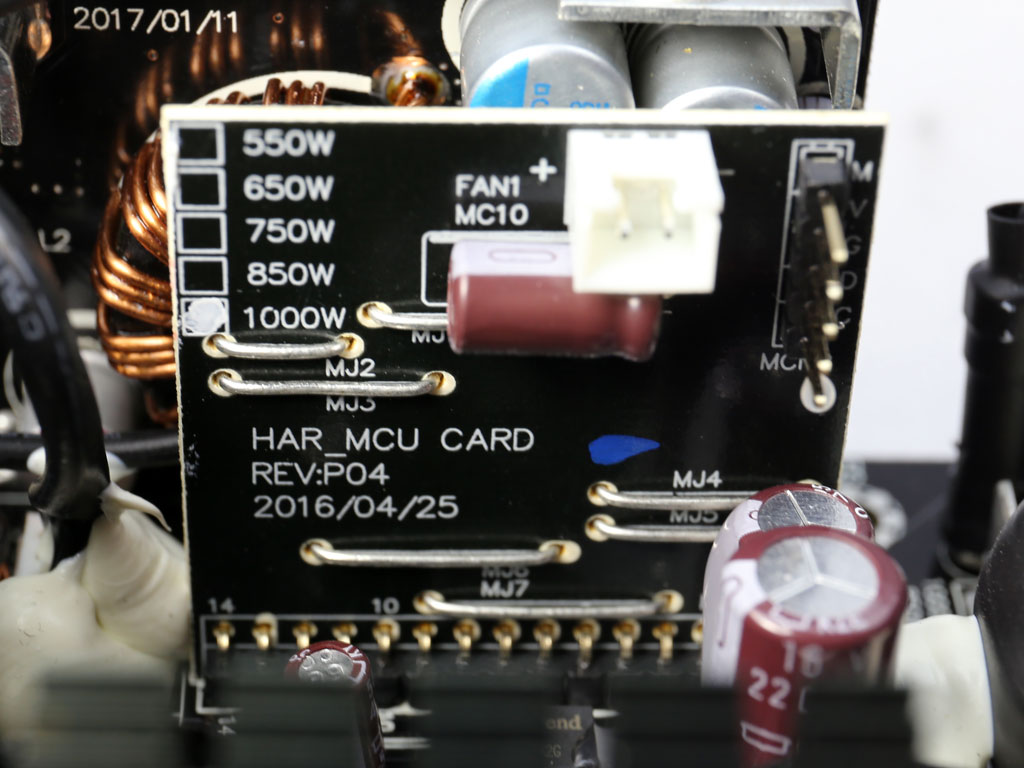Corsair HX1000 PSU Review
Why you can trust Tom's Hardware
Teardown & Component Analysis
Parts Description
Before proceeding with this page we strongly encourage you to a look at our PSUs 101 article, which provides valuable information about PSUs and their operation, allowing you to better understand the components we're about to discuss. Our main tools for disassembling PSUs are a Thermaltronics soldering and rework station and a Hakko FR-300 desoldering gun. Finally, for the identification of tiny parts we use an Andonstar HDMI digital microscope.
| General Data | |
|---|---|
| Manufacturer (OEM) | CWT |
| Platform Model | - |
| Primary Side | |
| Transient Filter | 6x Y caps, 2x X caps, 2x CM chokes, 1x MOV |
| Inrush Protection | NTC Thermistor & Relay |
| Bridge Rectifier(s) | 2x GBJ25L06 (600V, 25A @ 105°C) |
| APFC MOSFETs | 3x Infineon IPA50R140CP (550V, 15A @ 100°C, 0.14Ω) |
| APFC Boost Diode | 1x CREE C3D10060A (600V, 10A @ 153°C) |
| Hold-up Cap(s) | 1x Chemi-Con (400V, 680uF, 2000h @ 105°C, GG) 1x Nichicon (400V, 470uF, 2000h @ 105°C, KMW) |
| Main Switchers | 2x Vishay SIHG33N60E (650V, 21A @ 100°C, 0.099Ω) |
| APFC Controller | Infineon ICE3PCS01G - CM03X |
| LLC Resonant Controller | Infineon ICE2HS01G |
| Topology | Primary side: Half-Bridge & LLC Resonant Controller Secondary side: Synchronous Rectification & DC-DC converters |
| Secondary Side | |
| +12V MOSFETs | 10x Infineon BSC014N04LS (40V, 100A @ 100°C, 1.4mΩ) |
| 5V & 3.3V | DC-DC Converters: 6x Ubiq QM3004D (30V, 40A @ 100°C, 8.5mΩ) PWM Controller: 1x APW7159C |
| Filtering Capacitors | Electrolytics: Nippon Chemi-Con (1-5000 @ 105°C, KZE), Nippon Chemi-Con (4-10,000 @ 105°C, KY) Polymers: Nippon Chemi-Con, FPCAP |
| Supervisor IC | Weltrend WT7502 (OVP, UVP, PG, SCP), 2x Weltrend WT7518 (OCP, PG, SCP) |
| Fan Model | NR135P (135mm, 12V, 0.22A, Fluid Dynamic Bearing) |
| Fan Controller | Microchip PIC16F1503 |
| 5VSB Circuit | |
| Mosfet / Rectifier | 1x M03N65D / 1x MBRU2045CT SBR (45V, 20A @ 125°C) |
| Standby PWM Controller | On-Bright OB5269CP |





A quick look reveals that the HX1000 doesn't use the same platform as Corsair's HX1200, strange though it seems. Still, the HX1000's platform is modern, including a half-bridge topology on the primary side, along with an LLC resonant converter. On the secondary side, we find the usual: a synchronous rectification scheme for the +12V rail and a couple of DC-DC converters for generating the minor rails.
The build quality is high, and Corsair exclusively uses Japanese polymer and electrolytic capacitors for high reliability. As is usual for a CWT design, there are no heat sinks on the secondary side; only some bus bars handle the heat generated by the +12V FETs.


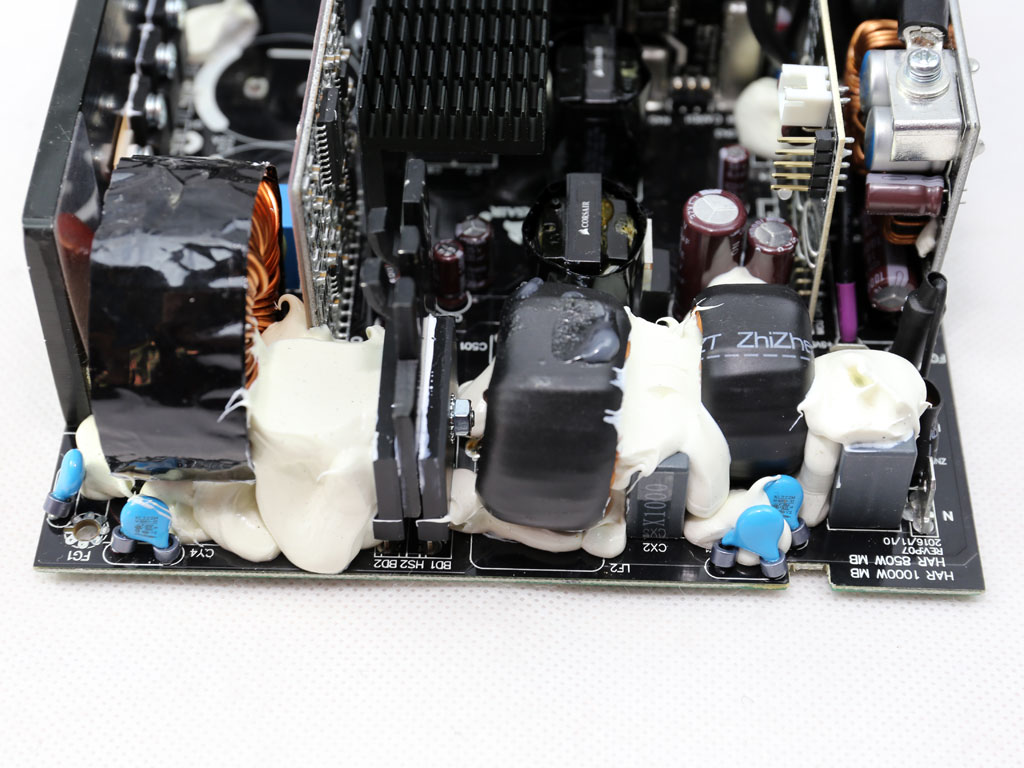

We only find a pair of Y caps at the AC receptacle. The transient filter's other parts are on the main PCB, including four Y and two X caps, two CM chokes, and an MOV.
There is an NTC thermistor for protecting against large inrush currents. It's supported by a bypass relay.


Two bridge rectifiers (GBJ25L06s) are bolted on a dedicated heat sink. Right next to them, the PFC input capacitor is totally covered in glue in an effort to minimize electronic noise.



In the APFC converter, we find three Infineon IPA50R140CP FETs and a CREE C3D10060A boost diode. The bulk caps are provided by Chemi-Con and Nichicon, and their combined 1150uF capacity is large enough to meet the demands of a 1kW PSU.
Get Tom's Hardware's best news and in-depth reviews, straight to your inbox.
The primary FETs, two Vishay SIHG33N60Es, are configured into a half-bridge topology. An LLC resonant converter is also used for reducing switching losses.
A vertical board hosts the LLC resonant controller, an Infineon ICE2HS01G IC. On the same board are also the APFC controller, an Infineon ICE3PCS01G, and a CM03X Green PFC controller.



Two daughterboards on the secondary side host 10 Infineon BSC014N04LS FETs that regulate the +12V rail.


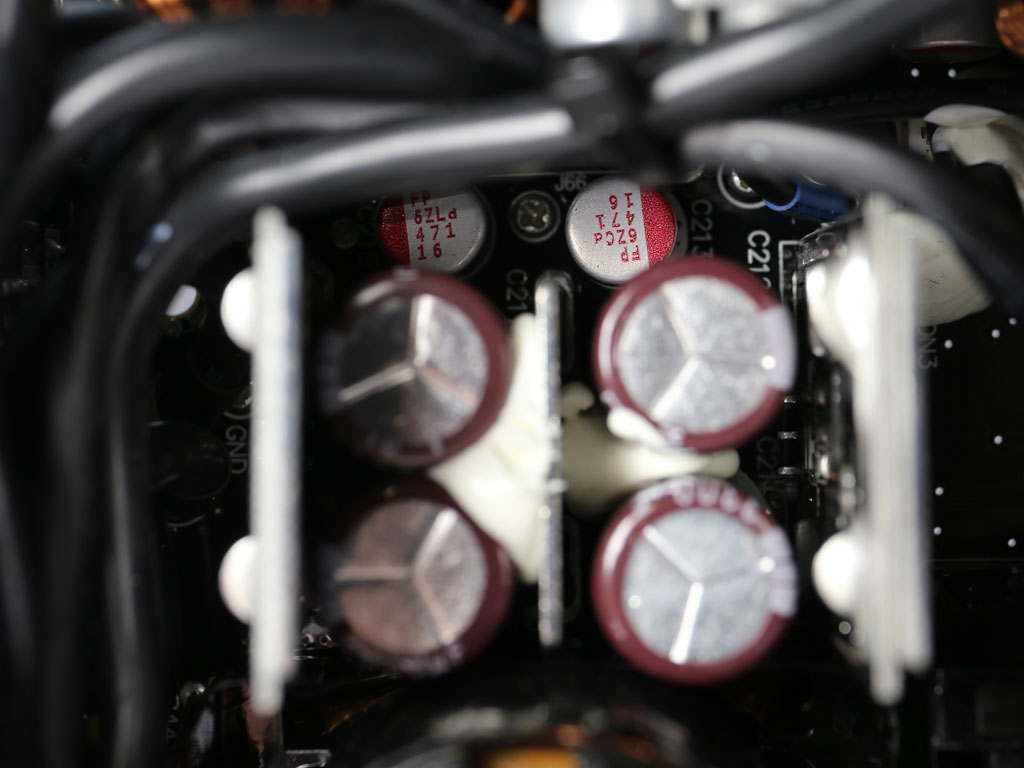
The electrolytic filtering caps on the secondary side are provided by Chemi-Con, and belong to its KZE and KY lines. Besides electrolytic caps a number of polymer caps are also used for filtering purposes. Those are provided by Chemi-Con and FPCAP.








The DC-DC converters use six Ubiq QM3004D FETs in total, and the common PWM controller is an Anpec APW7159C.


The 5VSB rail is regulated by a combination of a M03N65D FET and a MBRU2045CT SBR. The standby PWM controller is installed on the main PCB (it's an On-Bright OB5269CP).

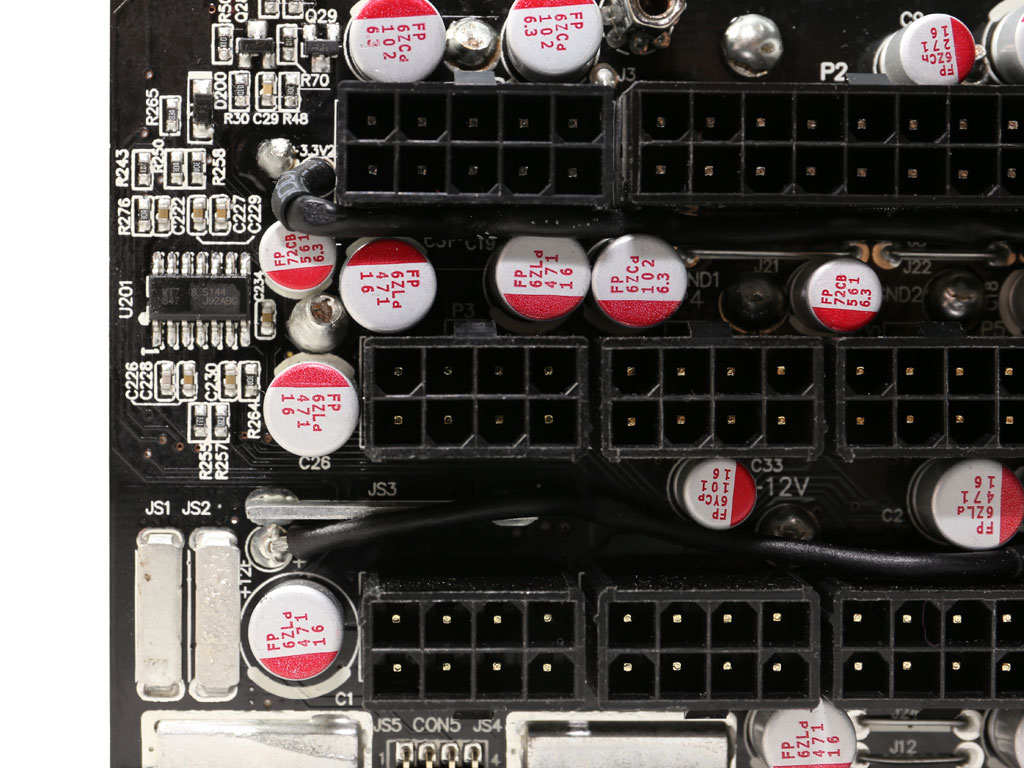


Many polymer caps, provided by FPCAP, are installed on the front side of the modular board.



On the back of the modular board, several thick wires transfer the minor rails, along with earth, to the sockets.


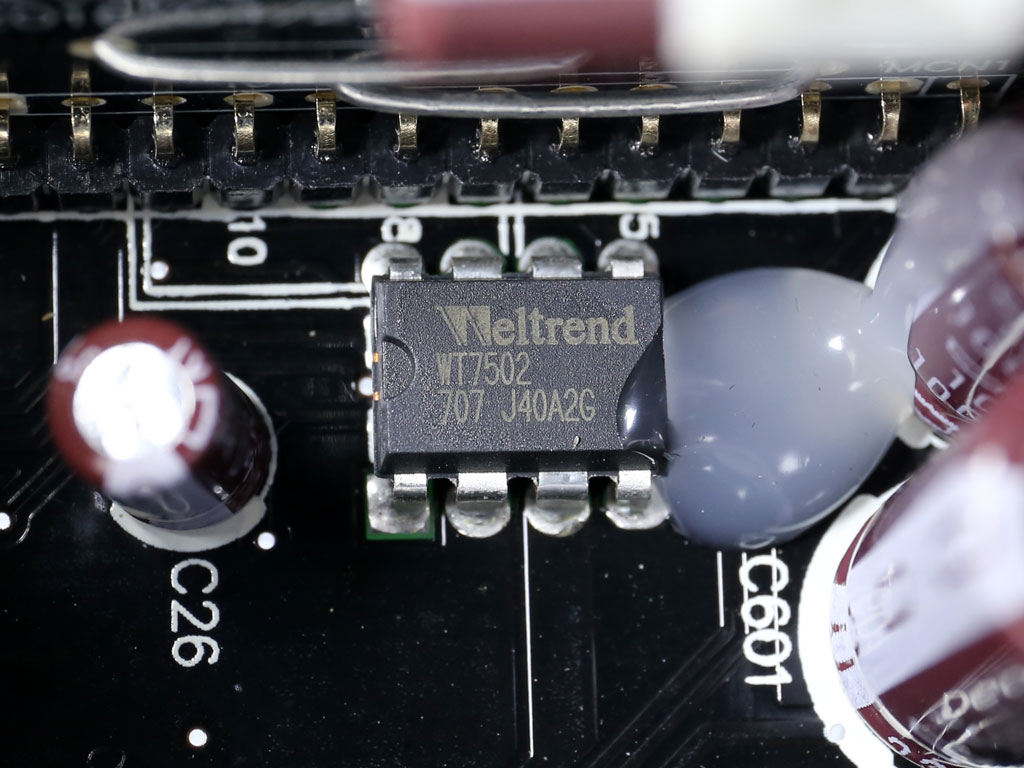
Two Weltrend WT7518s, along with a WT7502, handle the PSU's protection features. Both WT7518 ICs are installed on the modular board.










Once again, CWT's soldering quality comes close to perfection. We didn't expect anything less.
Corsair uses a Microchip PIC16F1503 to control fan speed. This allows it to adjust the fan profile easier and more effectively.


The HX1000 uses a NR135P fan (135mm, 12V, 0.22A). Thanks to its FDB bearing, it should last a long time. In general, this is a slow-spinning fan that doesn't make much noise, even at full speed.
MORE: Best Power Supplies
MORE: How We Test Power Supplies
MORE: All Power Supply Content
Current page: Teardown & Component Analysis
Prev Page Packaging, Contents, Exterior & Cabling Next Page Load Regulation, Hold-Up Time & Inrush Current
Aris Mpitziopoulos is a contributing editor at Tom's Hardware, covering PSUs.
-
samer.forums Can any one explain to me why we need such high end expensive power supplies for PCs ?Reply
I Overclock my PC fully , and I moved from (seasonic) Bronze grade power supply to Tier one expensive Titanium power supply and I did not gain anything in real life , nothing, Zero. the same performance and the same electric bill and both power supplies never failed.
Sure the better power supply on paper will give better results .. but they are way above the requirement of the PC hardware.
-
turkey3_scratch Reply20248574 said:Can any one explain to me why we need such high end expensive power supplies for PCs ?
I Overclock my PC fully , and I moved from (seasonic) Bronze grade power supply to Tier one expensive Titanium power supply and I did not gain anything in real life , nothing, Zero. the same performance and the same electric bill and both power supplies never failed.
Sure the better power supply on paper will give better results .. but they are way above the requirement of the PC hardware.
Overclocking the CPU is mostly dependent on the motherboard. It can be helped by having a better PSU, because in turn that makes it easier on the motherboard, but I wouldn't expect any major gains from getting a new power supply. I think it also depends on how much your CPU can overclock. People who are really pushing their CPUs to the maximum, they won the lottery and are really pushing it, they may benefit from a better PSU.
Your electric bill is only going to change depending on a lot of factors. Air conditioning and home appliances are going to take up 90% of your electric bill, and because the percentage of that bill making up your computer is so small it can almost be ignored at times. The change is so small that it is not distinguishable between your other household appliances most likely.
And getting a good PSU is not just for trying to help overclocking; a PSU with good performance will usually increase the lifespan of the rest of the computer, and one with bad performance will decrease the lifespan of the hardware. So if you plan on having your computer for many many years a good PSU is a good idea. If you plan on swapping parts every 1-2 years then PSU performance may be a lot less important to you.
Still, expensive PSUs have better build quality so the PSUs themselves are going to last longer, and if they're designed properly like this one they can be very quiet. Cheap PSUs can be loud. -
dstarr3 Reply20248805 said:20248574 said:Can any one explain to me why we need such high end expensive power supplies for PCs ?
I Overclock my PC fully , and I moved from (seasonic) Bronze grade power supply to Tier one expensive Titanium power supply and I did not gain anything in real life , nothing, Zero. the same performance and the same electric bill and both power supplies never failed.
Sure the better power supply on paper will give better results .. but they are way above the requirement of the PC hardware.
Overclocking the CPU is mostly dependent on the motherboard. It can be helped by having a better PSU, because in turn that makes it easier on the motherboard, but I wouldn't expect any major gains from getting a new power supply. I think it also depends on how much your CPU can overclock. People who are really pushing their CPUs to the maximum, they won the lottery and are really pushing it, they may benefit from a better PSU.
Your electric bill is only going to change depending on a lot of factors. Air conditioning and home appliances are going to take up 90% of your electric bill, and because the percentage of that bill making up your computer is so small it can almost be ignored at times. The change is so small that it is not distinguishable between your other household appliances most likely.
And getting a good PSU is not just for trying to help overclocking; a PSU with good performance will usually increase the lifespan of the rest of the computer, and one with bad performance will decrease the lifespan of the hardware. So if you plan on having your computer for many many years a good PSU is a good idea. If you plan on swapping parts every 1-2 years then PSU performance may be a lot less important to you.
Still, expensive PSUs have better build quality so the PSUs themselves are going to last longer, and if they're designed properly like this one they can be very quiet. Cheap PSUs can be loud.
That explains why one would buy high-quality PSUs, sure. But it doesn't explain why one would buy such high-wattage PSUs. Buying a 1000W PSU isn't going to benefit your machine if it only needs 500W on full load.
Now that 3- and 4-way SLI is on the outs, I can only assume it's just the miners that need so much wattage anymore. -
turkey3_scratch Reply20248811 said:That explains why one would buy high-quality PSUs, sure. But it doesn't explain why one would buy such high-wattage PSUs. Buying a 1000W PSU isn't going to benefit your machine if it only needs 500W on full load.
Now that 3- and 4-way SLI is on the outs, I can only assume it's just the miners that need so much wattage anymore.
Well you could take two overclocked 1080Tis, together those can be about 500W. Then if you have one of Intel or AMD's highest-end CPUs overclocked really well, that can be up to 150W probably if they have really good overclocks. Account for other stuff, probably around 725W under load. So in this case some people may buy a 1000W PSU, I don't know. But yeah, I see very few instances where someone would need one.
And some people do believe that buying a bit higher of a wattage will help it last longer. Whether true or not probably depends on a lot of factors like how the fan behaves and efficiency and other stuff.
But usually I like to get a PSU with better build quality and lower wattage than one with slightly less good build quality and higher wattage. -
padrescout It's the same reason Johnny Everyman buys a Dodge Hellcat. Nobody needs a 700 horsepower car to tool around town in. But some people like the image of having it. It implies things without saying anything and generally reflects positively on the owner in their social tribe.Reply
But mostly because a lot of people have more money than brains. -
turkey3_scratch Reply20249162 said:It's the same reason Johnny Everyman buys a Dodge Hellcat. Nobody needs a 700 horsepower car to tool around town in. But some people like the image of having it. It implies things without saying anything and generally reflects positively on the owner in their social tribe.
But mostly because a lot of people have more money than brains.
Assuming everybody buys something for the same reason isn't very reasonable. -
samer.forums Reply20248805 said:20248574 said:Can any one explain to me why we need such high end expensive power supplies for PCs ?
I Overclock my PC fully , and I moved from (seasonic) Bronze grade power supply to Tier one expensive Titanium power supply and I did not gain anything in real life , nothing, Zero. the same performance and the same electric bill and both power supplies never failed.
Sure the better power supply on paper will give better results .. but they are way above the requirement of the PC hardware.
Overclocking the CPU is mostly dependent on the motherboard. It can be helped by having a better PSU, because in turn that makes it easier on the motherboard, but I wouldn't expect any major gains from getting a new power supply. I think it also depends on how much your CPU can overclock. People who are really pushing their CPUs to the maximum, they won the lottery and are really pushing it, they may benefit from a better PSU.
Your electric bill is only going to change depending on a lot of factors. Air conditioning and home appliances are going to take up 90% of your electric bill, and because the percentage of that bill making up your computer is so small it can almost be ignored at times. The change is so small that it is not distinguishable between your other household appliances most likely.
And getting a good PSU is not just for trying to help overclocking; a PSU with good performance will usually increase the lifespan of the rest of the computer, and one with bad performance will decrease the lifespan of the hardware. So if you plan on having your computer for many many years a good PSU is a good idea. If you plan on swapping parts every 1-2 years then PSU performance may be a lot less important to you.
Still, expensive PSUs have better build quality so the PSUs themselves are going to last longer, and if they're designed properly like this one they can be very quiet. Cheap PSUs can be loud.
I never had any power supply fails all my life ... last time I changed a power supply was for low voltage haswell issue and not because my old one died.
Even one of my Plus 80 (below bronze) powersupply lasted 7 years without any issues, I only buy Seasonic by the way and Corsair.
and for motherboards parts , they never failed as well
Life span is not a big deal when you buy a good brand that follow the standard specifications for the pc parts.
I still need a valid reason to convince me that buying an expensive powersupply is better in real life and not on paper. -
turkey3_scratch The original Seasonic-made Corsair HX power supplies from 2008, i.e. one like this, had RMA rated above 10% they were so unreliable (I received this info on the Jonnyguru forums a while back). So really you can't just go by brand. And you may have not had failures personally, but other people have. Personal experience does not dictate the broader spectrum.Reply -
samer.forums Reply20249230 said:The original Seasonic-made Corsair HX power supplies from 2008, i.e. one like this, had RMA rated above 10% they were so unreliable (I received this info on the Jonnyguru forums a while back). So really you can't just go by brand. And you may have not had failures personally, but other people have. Personal experience does not dictate the broader spectrum.
I am not talking about fail rate . I am talking about what I get for paying for high end powersupply and I want to see if they are overkill and not needed at all or not. fail rate is something else. you can get a cheap Bronze powersupply with low fail rate . -
Larmo-Ct For "future proofing", I always buy 1200 Watt PSUs.. As Tim the "Tool Man Taylor" in the old Home Improvement TV show, use to say.. "Mooore poowwerr!! Awh.. Awh..!" :-)Reply



